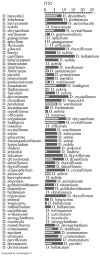Molecular Identification of Dendrobium Species (Orchidaceae) Based on the DNA Barcode ITS2 Region and Its Application for Phylogenetic Study
- PMID: 26378526
- PMCID: PMC4613292
- DOI: 10.3390/ijms160921975
Molecular Identification of Dendrobium Species (Orchidaceae) Based on the DNA Barcode ITS2 Region and Its Application for Phylogenetic Study
Abstract
The over-collection and habitat destruction of natural Dendrobium populations for their commercial medicinal value has led to these plants being under severe threat of extinction. In addition, many Dendrobium plants are similarly shaped and easily confused during the absence of flowering stages. In the present study, we examined the application of the ITS2 region in barcoding and phylogenetic analyses of Dendrobium species (Orchidaceae). For barcoding, ITS2 regions of 43 samples in Dendrobium were amplified. In combination with sequences from GenBank, the sequences were aligned using Clustal W and genetic distances were computed using MEGA V5.1. The success rate of PCR amplification and sequencing was 100%. There was a significant divergence between the inter- and intra-specific genetic distances of ITS2 regions, while the presence of a barcoding gap was obvious. Based on the BLAST1, nearest distance and TaxonGAP methods, our results showed that the ITS2 regions could successfully identify the species of most Dendrobium samples examined; Second, we used ITS2 as a DNA marker to infer phylogenetic relationships of 64 Dendrobium species. The results showed that cluster analysis using the ITS2 region mainly supported the relationship between the species of Dendrobium established by traditional morphological methods and many previous molecular analyses. To sum up, the ITS2 region can not only be used as an efficient barcode to identify Dendrobium species, but also has the potential to contribute to the phylogenetic analysis of the genus Dendrobium.
Keywords: DNA barcode; Dendrobium; ITS2; genetic relationship; species identification.
Figures


References
-
- Wang H.Z., Feng S.G., Lu J.J., Shi N.N., Liu J.J. Phylogenetic study and molecular identification of 31 Dendrobium species using inter-simple sequence repeat (ISSR) markers. Sci. Hortic. 2009;122:440–447. doi: 10.1016/j.scienta.2009.06.005. - DOI
-
- Tsi Z.H., Chen S.C., Luo Y.B., Zhu G.H. Flora Republicae Popularis Sinicae. Science Press; Beijing, China: 1999. Orchidaceae (3)
-
- Adams P.B. Systematics of Dendrobiinae (Orchidaceae), with special reference to Australian taxa. Bot. J. Linn. Soc. 2011;166:105–126. doi: 10.1111/j.1095-8339.2011.01141.x. - DOI
-
- Xiang X.G., Schuiteman A., Li D.Z., Huang W.C., Chung S.W., Li J.W., Zhou H.L., Jin W.T., Lai Y.J., Li Z.Y., et al. Molecular systematics of Dendrobium (Orchidaceae, Dendrobieae) from mainland Asia based on plastid and nuclear sequences. Mol. Phylogenet. Evol. 2013;69:950–960. doi: 10.1016/j.ympev.2013.06.009. - DOI - PubMed
Publication types
MeSH terms
Substances
LinkOut - more resources
Full Text Sources
Other Literature Sources
Research Materials
Miscellaneous

